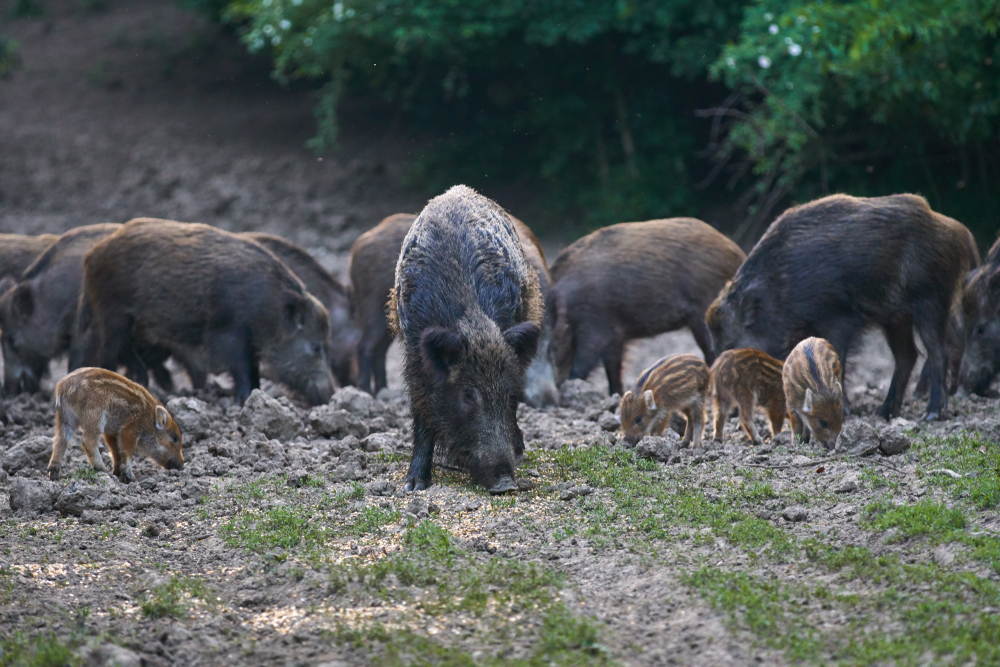While there’s significant uncertainty in the study, it shows how damaging these hogs can be.

The pig is one of the most adaptable mammal species on the planet.
Thanks to that adaptability, it’s found just about everywhere, from sub-Saharan Africa to the Amazon rainforest. Non-native species don’t always cause damage, but the pig’s habits are known to destroy the habitats of endangered animals, pollute waterways and carry diseases. One element has been understudied, though: Does the wallowing and digging of non-native pigs release carbon dioxide trapped in the soil? A new study from researchers at the University of Queensland and University of Canterbury finds that wild pigs are responsible for emitting an equivalent amount of carbon dioxide into the atmosphere as millions of gas-powered cars.
Researchers restricted the study to areas where the wild boar is not native, which excludes most of temperate Europe and Asia. They used a model for predicting densities of large mammals to guess how many hogs there are per square kilometer, which creates results that vary based on environment, the presence of large predators, weather, that kind of thing.
Then the researchers used the results of a 15-year-long study that measured the soil disturbance of wild pigs, a study that looked at 700 different samples of hog habitats, and then used a model to combine those two factors. As is standard in this type of study, where you’re trying to analyze something without actually being there, the researchers ran a model many times (in this case, 10,000 times) to simulate all the possibilities of how much soil disturbance there could be. Then they looked at the median and mean of those 10,000 results.
The researchers in this study use the phrase “wild pigs” and identify that species as Sus scrofa, which might be better known as the wild boar. Where this gets tricky is that Sus scrofa is also the species for feral hogs; domestic pigs are Sus scrofa domesticus, as they were domesticated from the wild boar, but if one of those animals escapes and lives in the wild or gives birth to animals that live in the wild, all of those would be Sus scrofa. The wild boar also frequently mates with feral hogs, creating hybrids that are difficult to tell apart from either of their parents. This study doesn’t discriminate between feral hogs and the Eurasian wild boar, those both having the same species name. This doesn’t mean that there aren’t differences between, say, a second-generation feral pig and a Eurasian wild boar in behavior, but it’s awfully difficult to separate the two.
This species of animal—both the wild boar and the feral pig—is known for its soil disturbance skills. A large chunk of its diet comes from subterranean foods such as roots and insect grubs, and the animal’s behavior involves a lot of rooting, digging and wallowing. They’re sometimes known as “ecosystem engineers,” like beavers and woodpeckers; they physically alter their environment. But these hogs can cause a tremendous amount of damage by accelerating erosion, polluting runoff and uprooting tree saplings.
Soils can serve as carbon sinks, capable of storing massive amounts of carbon dioxide, which keeps them out of the atmosphere. Disturbing that soil can release that stored carbon dioxide, which is one reason for techniques such as no-till agriculture.
The researchers found a gigantic gap in their findings between the median and mean, meaning that there’s a pretty large amount of uncertainty in this study. But both figures were quite high: The median clocked in at 4.87 million metric tonnes of carbon dioxide emissions per year from soil disturbance, while the mean was a whopping 16.97 million metric tonnes. That’s the equivalent, respectively, of the carbon dioxide emissions of 1.1 million and 3.7 million passenger cars. The worst spots? North America and Oceania, although the Amazon area, owing to its massive amounts of carbon dioxide stored in tropical soils, wasn’t far behind despite having far fewer hogs.
The researchers also found that Oceania was especially ripe for action: Despite having only 6 percent of the planet’s land, it had more than 60 percent of emissions from wild hog soil disturbances. Australia, with high numbers of endemic plants and animals, has long struggled to control non-native species, with more failures than successes.
Hawaiian Islands, which is part of Oceania, has long had a problem with feral pigs. From the time I began hiking in relatively remote areas on O’ahu, Maui, Molokai, and the Island of Hawai’i, I can attest to the damage caused by feral pigs. Example: in summer 1976, I was part of a student-originated baseline survey of a portion of the southern flank of Haleakala, Maui, that was being considered by the National Park Service for inclusion in Haleakala National Park. The amount of pig and feral goat damage was amazing. In the higher altitude wet grasslands (over 7,000 feet… Read more »
It’s interesting to see the effects that wild boars and feral pigs can have to land they aren’t native to. Why did the researchers focus on those lands rather than looking at their natural habitats? Is there less of an impact on the land they are native to?